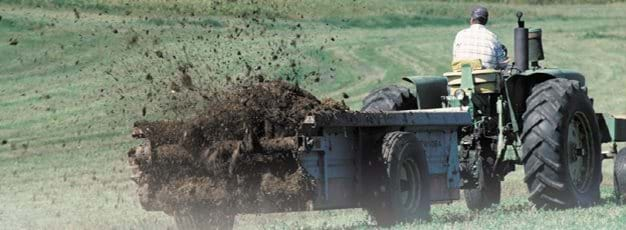Manure Management: A Growing Challenge in the Chesapeake Bay Watershed

Farmers who run confined animal feeding operations (hog, cattle, dairy, and poultry farms) usually dispose of manure by spreading it on cropland as a soil amendment and source of nutrients. Because manure is expensive to transport, producers may apply more than crops can use, especially on fields nearest the production facility. Excessive manure applications increase the potential for contamination of surface and ground water. To address water quality concerns, USDA and the U.S. Environmental Protection Agency (EPA) together developed a strategy for improving manure management. A primary emphasis of the joint strategy is to limit application of manure nutrients to rates that the soil can store and crops can use. USDA will provide technical and financial assistance to help operators develop and implement comprehensive nutrient management plans (CNMPs). EPA published regulations in February 2003 that will require over 15,000 concentrated animal feeding operations to implement CNMPs. This emphasis on manure management presents a new challenge to large livestock and poultry operations, particularly in areas with relatively high animal concentrations such as the Chesapeake Bay watershed, which covers parts of Maryland, Virginia, West Virginia, Delaware, Pennsylvania, and New York.
Recent ERS analysis indicates that better manure management will likely require manure to be applied to more land than currently, raising hauling costs for many animal producers. An operator’s need to access additional land for manure application will depend on the volume of manure for disposal relative to cropland area currently receiving manure and the nutrient uptake of the crops. The willingness of crop farmers to accept manure on their land—considering manure’s variable nutrient content, potential odor, and handling cost—affects the amount of land available for manure application and the distance manure must be hauled. A low willingness by crop producers to accept manure may cause some manure to be hauled long distances to access sufficient land to avoid overapplication of manure nutrients.
As part of the ERS study, analysts examined the feasibility and cost of applying manure in the Chesapeake Bay watershed at rates not exceeding crop uptake. For all the nitrogen in manure to be used by crops within 100 miles of the manure’s origin, crop farmers in the region would have to accept manure as the only nitrogen fertilizer source on at least 20 percent of total cropland. Under a more stringent standard, where applied manure does not exceed crop phosphorus needs, crop farmers within a 100-mile radius would have to accept manure as the only phosphorous source on at least 60 percent of the total cropland.
USDA financial and technical assistance in managing and utilizing the nutrients in manure could increase crop farmers’ willingness to accept manure application on their land. Where hauling costs for manure land application are high, the ERS analysis indicates potential to reduce the amount of land receiving manure by expanding industrial processes that use manure to produce energy or commercial fertilizer products, and by feeding animal rations that lessen manure nutrient content.
Manure Management for Water Quality: Costs to Animal Feeding Operations of Applying Manure Nutrients to Land, by Marc Ribaudo, Noel Gollehon, Marcel Aillery, Jonathan Kaplan, Robert Johansson, Jean Agapoff, Lee Christensen, Vince Breneman, and Mark Peters, USDA, Economic Research Service, June 2003


